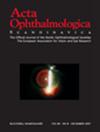The relationship between social deprivation and glaucoma-related quality of life (QOL)
Abstract
Aims/Purpose: Glaucoma carries a considerable global health burden. As it is generally accepted that glaucoma is incurable, it is critical to maintain or improve the QOL of afflicted patients.
Social deprivation is known to be associated with poor vision. However, less is known about the relationship between social deprivation and its impact on glaucoma-related QOL.
It must be noted that QOL is an entirely different concept as a glaucoma patient with poor vision could still maintain a good vision-related QOL.
The purpose of this project was to identify a potential gap in the provision of care for socially deprived glaucoma patients and advance the European Glaucoma Society's aim of glaucoma treatment, which is to maintain QOL in affected patients at a sustainable cost.
- Systematic Literature Review to determine the best instruments to measure social deprivation and glaucoma-related QOL
- Patient Questionnaire Study (280 patients) to investigate the correlation between social deprivation and glaucoma-related QOL
- Statistical Analysis of the results from the Patient Questionnaire Study
It was decided that the best tool to assess social deprivation was the Scottish Index of Multiple Deprivation (SIMD) and the best instrument to measure glaucoma-related QOL in this context was the 25-item National Eye Institute Visual Functioning Questionnaire (VFQ-25).
Results: 280 patients, 142 males and 138 females, undertook the questionnaire.
The mean age was 73, all of Caucasian race.
Those with lower SIMD scores (more socially deprived) reported lower VFQ-25 scores (lower quality of life).
Statistical analysis established that Pearson correlation coefficient r = 0.535 with p-value = 0.011
The significance threshold was set at 0.05 for the p-value.
Conclusions: This study has now established that greater social deprivation leads to a lower glaucoma-related QOL, which encompasses the physical, psychological, emotional and social well-being of the patient.
This is extremely useful as it highlights that more can and should be done to help socially deprived glaucoma patients. The research poster proposes some measures to implement to help improve the overall well-being of socially deprived glaucoma patients, and thereby maintain their independence and QOL.

 求助内容:
求助内容: 应助结果提醒方式:
应助结果提醒方式:


